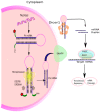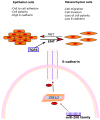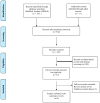The miRNA Mirage: How Close Are We to Finding a Non-Invasive Diagnostic Biomarker in Endometriosis? A Systematic Review
- PMID: 29463003
- PMCID: PMC5855821
- DOI: 10.3390/ijms19020599
The miRNA Mirage: How Close Are We to Finding a Non-Invasive Diagnostic Biomarker in Endometriosis? A Systematic Review
Abstract
Background: Endometriosis is a common disorder of the reproductive age group, characterised by the presence of ectopic endometrial tissue. The disease not only causes enormous suffering to the affected women, but also brings a tremendous medical and economic burden to bear on society. There is a long lag phase between the onset and diagnosis of the disease, mainly due to its non-specific symptoms and the lack of a non-invasive test. Endometriosis can only be diagnosed invasively by laparoscopy. A specific, non-invasive test to diagnose endometriosis is an unmet clinical need. The recent discovery of microRNAs (miRNAs) as modulators of gene expression, and their stability and specificity, make them an attractive candidate biomarker. Various studies on miRNAs in endometriosis have identified their cardinal role in the pathogenesis of the disease, and have proposed them as potential biomarkers in endometriosis. Rationale/Objectives: The aims of this review were to study the role of circulatory miRNAs in endometriosis, and bring to light whether circulatory miRNAs could be potential non-invasive biomarkers to diagnose the disease.
Search methods: Three databases, PubMed, EMBASE, and BIOSIS were searched, using a combination of Mesh or Emtree headings and free-text terms, to identify literature relating to circulating miRNAs in endometriosis published from 1996 to 31 December 2017. Only peer-reviewed, full-text original research articles in English were included in the current review. The studies meeting the inclusion criteria were critically assessed and checked using the QUADAS-2 (Quality Assessment of Diagnostic Accuracy Studies) tool. The dysregulated miRNAs were assessed regarding the concordance between the various studies and their role in the disease.
Outcomes: Nine studies were critically analysed, and 42 different miRNAs were found to be dysregulated in them, with only one common miRNA (miR-20a) differentially expressed in more than one study. miR-17-5p/20a, miR-200, miR-199a, miR-143, and miR-145 were explored for their pivotal role in the aetiopathogenesis of endometriosis. Wider implications: It is emerging that miRNAs play a central role in the pathogenesis of endometriosis and have the potential of being promising biomarkers. Circulating miRNAs as a non-invasive diagnostic tool may shorten the delay in the diagnosis of the disease, thus alleviating the suffering of women and reducing the burden on health care systems. However, despite numerous studies on circulating miRNAs in endometriosis, no single miRNA or any panel of them seems to meet the criteria of a diagnostic biomarker. The disagreement between the various studies upholds the demand of larger, well-controlled systematic validation studies with uniformity in the research approaches and involving diverse populations.
Keywords: biomarker; circulating; endometriosis; microRNA; non-invasive.
Conflict of interest statement
The authors declare no conflict of interest.
Figures






References
-
- Wilson J., Beecham C., Carrington E. Endometriosis. Obstet. Gynecol. 1975;8:110–118.
-
- Rogers P.A.W., D’Hooghe T.M., Fazleabas A., Gargett C.E., Giudice L.C., Montgomery G.W., Rombauts L., Salamonsen L.A., Zondervan K.T. Priorities for endometriosis research: Recommendations from an international consensus workshop. Reprod. Sci. 2009;16:335–346. doi: 10.1177/1933719108330568. - DOI - PMC - PubMed
-
- Adamson G.D., Kennedy S., Hummelshoj L. Creating solutions in endometriosis: Global collaboration through the World Endometriosis Research Foundation. J. Endometr. 2010;2:3–6.
Publication types
MeSH terms
Substances
LinkOut - more resources
Full Text Sources
Other Literature Sources
Medical
Molecular Biology Databases

